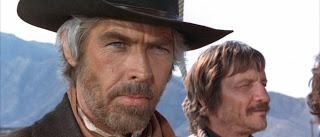 Tonino Valerii's A Reason to Live, a Reason to Die (1972) is the sort of Spaghetti Western where the main draw is its over-elaborate English title. It has a decent-enough premise - The Dirty Dozen out West - but does little more than march cheaply through the motions.
Tonino Valerii's A Reason to Live, a Reason to Die (1972) is the sort of Spaghetti Western where the main draw is its over-elaborate English title. It has a decent-enough premise - The Dirty Dozen out West - but does little more than march cheaply through the motions.Union Colonel Pembroke (James Coburn) is disgraced after surrendering Ft. Holman, an outpost in New Mexico, to Confederate Major Ward (Telly Savalas) without firing a shot. To redeem himself, Pembroke accepts a charge from Major Ballard (Jose Suarez) to lead a squad of condemned criminals to recapture the fort. Pembroke finds his recruits less-than-excited until he claims that the fort contains a buried cache of gold. With few resources beyond their wits, six-guns and a few sticks of dynamite, Pembroke's gang seeks revenge against Ward, who has a deadly trap waiting.
A Reason to Live, a Reason to Die shows all the flaws of your average Spaghetti Western: a sloppy plot, atrocious dubbing, an over-reliance on action scenes. Watching Pembroke's men engage in "witty" tough guy banter with mangled voices makes one long for the laconic silence of a Clint Eastwood or Franco Nero. James Coburn is reliably cool, but the oddball assortment of Euro-actors - Bud Spencer, Terence Hill's hulking sidekick in the Trinity films; Angel Alvarez of Django; the inevitable Benito Stefanelli; Reinhard Koldehoff, the depraved Brownshirt from Visconti's The Damned - make little impression. Telly Savalas doesn't even appear until the halfway mark; his sole acting choice is to make Ward a decadent homosexual who gropes at a nude statue between battles.
The English-language cut (there's a longer Italian version that's harder to find) suffers particularly from herky-jerky editing that renders the story almost insensible. The narrative lurches from scene to scene, set piece to set piece with no exposition and rarely a proper transition. Pembroke reveals a bold plan to sneak aboard a Confederate troop train; in the very next scene they're already on the train. Conflict, and suspense averted! Similarly, a potentially tense scene at a rest stop is squandered when one of Pembroke's men blathers their mission from the word go; it serves no purpose other than outfitting them with Confederate uniforms.
After about an hour of rambling build-up, Reason to Live finally gets down to brass tacks. Pembroke's men infiltrate the fort, blast through the defenses and cut down dozens of Rebels with machine guns and dynamite. For awhile there's an interesting interplay as Pembroke and Ward try and outwit each other, but mostly the denouement is what you'd expect: scenes of mass murder disguised as entertainment. Admittedly, there aren't many films where a character will cry out "Go fly a kite!" while executing surrendering enemies, while Savalas's character gets a death scene that's protracted to comic extremes.
Such are the delights of even terrible Spaghetti Westerns. That and the familiar locations, from sets left over from Once Upon a Time in the West and El Condor to the ubiquitous Almerian desert, and the jangly fuzz guitar score from Riz Ortolani. Spaghettis can be high art, or unpretentious, pulpy fun. Sometimes, though, they're just bad - and that's where A Reason to Live, A Reason to Die falls.

